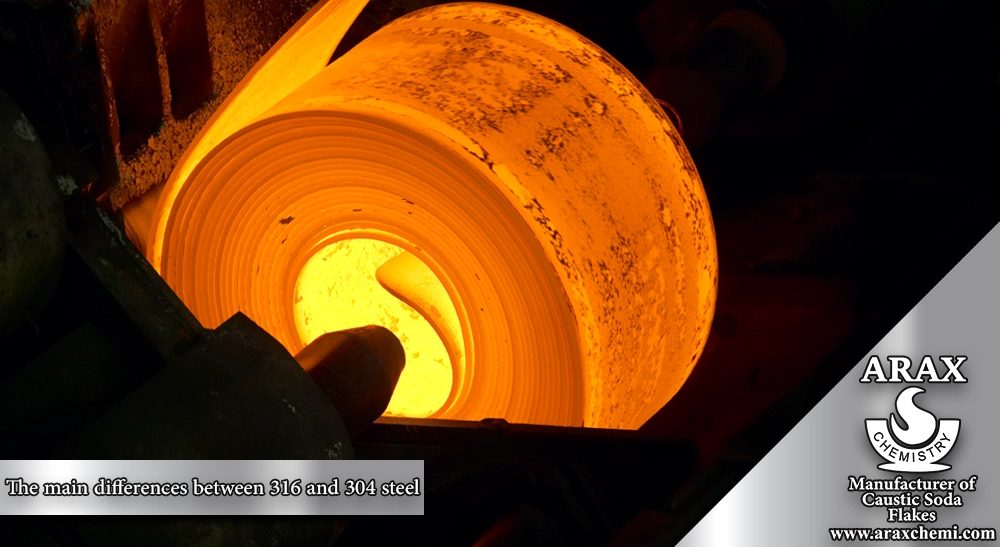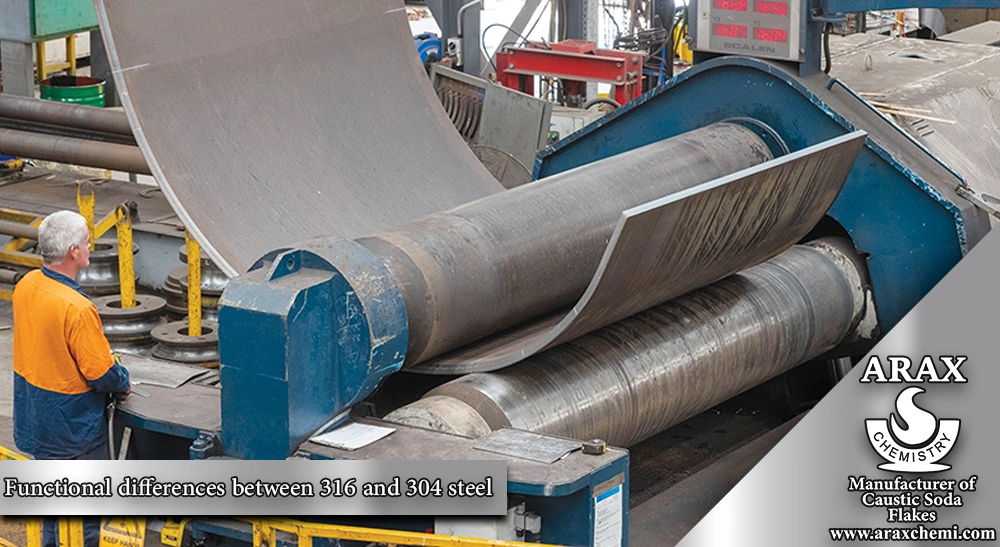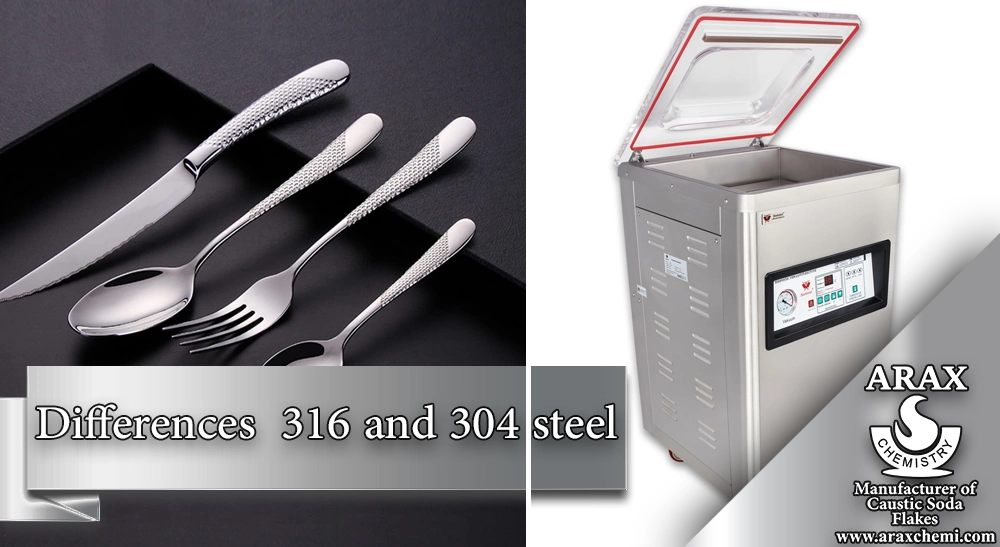After the Industrial Revolution, steel became one of the most widely used and important alloys in various industries. Over the past few centuries, the use of this crucial material has steadily increased. For instance, in 2010, the average monthly global consumption of steel was about 2.5 million tons, but this figure rose to approximately 4.5 million tons by 2024.
This significant growth underscores steel’s escalating importance in diverse applications. Among the most popular types of stainless steel are grades 316 and 304. This article explores the difference between stainless steel 316 and 304.
Difference in Chemical Composition and Resistance

Both stainless steel 316 and 304 share many similarities but also exhibit notable difference. Key distinctions lie in:
- Chemical composition
- Corrosion resistance
- Heat resistance
Chemical Composition Difference
Stainless steel 304 consists of 18% chromium and 8% nickel, which provides good resistance to corrosion and rust. In contrast, stainless steel 316 contains 16% chromium, 10% nickel, and 2-3% molybdenum. The addition of molybdenum enhances 316 steel’s resistance to corrosion and cracking.
Corrosion Resistance Differences
A significant difference between stainless steel 316 and 304 is their corrosion resistance. Due to its molybdenum content, stainless steel 316 offers superior corrosion resistance, making it more suitable for chemical and marine environments. While stainless steel 304 also resists corrosion well, it may struggle in highly corrosive settings such as salty environments.
Heat Resistance Differences
Stainless steel 304 can withstand temperatures up to about 870°C, providing good heat resistance. However, stainless steel 316 performs even better under heat, tolerating temperatures up to 925°C. This makes 316 steel ideal for industrial applications requiring high-temperature resistance, such as chemical processing and marine equipment.
Physical Differences
The physical difference between stainless steel 316 and 304 include appearance, formability, and machinability. The presence of molybdenum in 316 steel enhances its corrosion resistance and durability in harsh conditions but makes it slightly harder to form and machine compared to 304 steel. Both types exhibit a shiny, smooth surface, with minimal differences in appearance.
Appearance
Both stainless steel 304 and 316 have a shiny, smooth finish, offering aesthetic appeal. However, in applications requiring frequent cleaning and disinfection, stainless steel 316 is preferable due to its higher resistance to chemicals and disinfectants.
Formability and Machinability
Stainless steel 304 is highly flexible and formable, making it suitable for various industries. It can be easily shaped into different forms. Although stainless steel 316 also boasts good formability, its enhanced corrosion resistance makes it slightly harder to form.
Magnetic Properties
Stainless steel 304 is generally non-magnetic but can become magnetic through cold working. In contrast, stainless steel 316 remains non-magnetic, a crucial feature for specific applications.
Practical Differences
Stainless steel 316 and 304 are widely used across many industries, but each is better suited for particular applications:
Chemical and Marine Environments
- Stainless Steel 316: With its higher corrosion resistance due to molybdenum, it is ideal for chemical and marine environments and structures requiring high corrosion resistance, such as coastal structures and bridges.
- Stainless Steel 304: Though corrosion-resistant, it may struggle in highly corrosive environments. It is better suited for architectural structures, railings, and building facades that do not require extreme environmental resistance.
Food and Pharmaceutical Industries
- Stainless Steel 316: Its high resistance to chemicals and disinfectants makes it perfect for food and pharmaceutical processing equipment.
- Stainless Steel 304: Commonly used in the food industry, kitchen equipment and household appliances, it offers good resistance to food and beverages.
Medical and Surgical Equipment
- Stainless Steel 316: Frequently used in medical and surgical equipment due to its resistance to frequent cleaning with disinfectants.
- Stainless Steel 304: Used in some medical equipment but with less resistance to disinfectants.
High-Temperature Applications

- Stainless Steel 316: Suitable for high-temperature industrial equipment, such as furnaces and chemical processing equipment, due to its superior heat resistance.
- Stainless Steel 304: Offers good heat resistance but may not perform as well as 316 steel at very high temperatures.
Economic Differences
Stainless steel 316 is more expensive to produce due to the inclusion of molybdenum, which enhances its corrosion resistance and longevity. While the initial cost is higher, it offers long-term savings by reducing maintenance and replacement needs in harsh environments.
Conversely, stainless steel 304 is less costly to produce as it lacks molybdenum. It still provides good corrosion resistance, making it economical for many applications. However, in corrosive environments, it may require earlier replacements, increasing costs over time.
In summary, stainless steel 316 is more cost-effective in severe industrial and corrosive environments, whereas stainless steel 304 is a cost-efficient choice for general applications.
Environmental Compatibility

Both stainless steel 304 and 316 are recyclable and environmentally friendly. Recycling these materials reduces the consumption of natural resources and energy, minimizing industrial waste. Thus, the use of stainless steel contributes to reducing environmental impacts.
Conclusion
Stainless steel 304 and 316 are among the most widely used types of stainless steel across various industries. The choice between them depends on specific application requirements. Stainless steel 304, with its lower cost and sufficient corrosion resistance, is an economical and versatile option. In contrast, stainless steel 316, with its enhanced corrosion resistance and durability in harsh conditions, is suitable for industrial and marine applications. Understanding these differences allows for the optimal selection of steel for each specific use.
Frequently Asked Questions
- What factors cause the difference in corrosion resistance between stainless steel 316 and 304?
The difference in corrosion resistance stems from their chemical compositions. Stainless steel 316 contains 2-3% molybdenum, increasing its resistance to corrosion, particularly in salty and chemical environments. Stainless steel 304 lacks molybdenum, which makes it less resistant in highly corrosive settings. - Which type of stainless steel is more suitable for high-temperature applications, 304 or 316?
Stainless steel 316, due to its molybdenum content, offers better heat resistance than stainless steel 304. This makes it ideal for high-temperature applications such as chemical processing equipment and marine environments. While 304 also provides good heat resistance, it may not perform as well at very high temperatures. - Is stainless steel 316 always the best choice considering its higher corrosion resistance?
The choice between stainless steel 316 and 304 should be based on the specific needs of the application. Although stainless steel 316 incurs higher costs, it can result in long-term savings in highly corrosive environments due to reduced maintenance and replacement needs. Stainless steel 304 is more economical and performs well in many applications, making it a better choice when extremely high corrosion resistance is not required. However, for severely corrosive or high-temperature environments, stainless steel 316 is the more suitable option.

